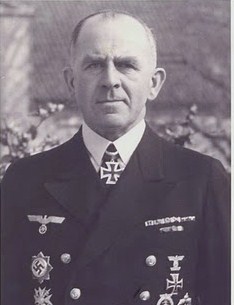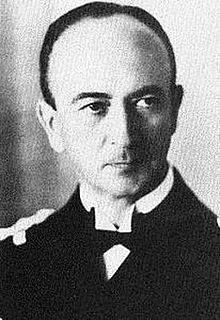
The Kriegsmarine was the navy of Nazi Germany from 1935 to 1945. It superseded the Imperial German Navy of the German Empire (1871–1918) and the inter-war Reichsmarine (1919–1935) of the Weimar Republic. The Kriegsmarine was one of three official branches, along with the Heer (Army) and the Luftwaffe of the Wehrmacht, the German armed forces from 1933 to 1945.
Hans Hermann Ludwig von Reuter was a German admiral who commanded the High Seas Fleet when it was interned at Scapa Flow at the end of World War I. On 21 June 1919 he ordered the scuttling of the German fleet in Scapa Flow to prevent the British from seizing the ships.
Hermann Bauer was a German naval officer who served as commander of the U-boat forces of the Kaiserliche Marine during World War I. In addition to his World War I career, Bauer is well known as the author of the book Das Unterseeboot, a treatise on the design and operation of U-boats, which was later translated into English by Hyman G. Rickover. Rickover's translation became a basic text for the US submarine service.
Plan Z was the name given to the planned re-equipment and expansion of the Kriegsmarine ordered by Adolf Hitler in early 1939. The fleet was meant to challenge the naval power of the United Kingdom, and was to be completed by 1948. Development of the plan began in 1938, but it reflected the evolution of the strategic thinking of the Oberkommando der Marine over the two decades following World War I. The plan called for a fleet centered on ten battleships and four aircraft carriers which were intended to battle the Royal Navy. This force would be supplemented with numerous long-range cruisers that would attack British shipping. A relatively small force of U-boats was also stipulated.

Otto Ciliax was a German naval officer who served in the navies of the German Empire, the Weimar Republic and Nazi Germany. As an admiral during World War II, he commanded the German battleships. He was a recipient of the Knight's Cross of the Iron Cross.

VizeadmiralLothar von Arnauld de la Perière, born in Posen and of French-German descent, was a German U-boat commander during World War I. With 194 ships and 453,716 gross register tons (GRT) sunk, he is the most successful submarine captain ever. His victories came in the Mediterranean, almost always using his 8.8-cm deck gun. During his career he fired 74 torpedoes, hitting 39 times.

Adolf von Trotha was a German admiral in the Kaiserliche Marine. After the German revolution he briefly served as the first Chef der Admiralität, which replaced the imperial Reichsmarineamt. After supporting the Kapp-Lüttwitz Putsch of March 1920 he resigned his post.
KriegsmarinewerftWilhelmshaven was, between 1918 and 1945, a naval shipyard in the German Navy's extensive base at Wilhelmshaven,.

Otto Schniewind was a German General Admiral during World War II. He was a recipient of the Knight's Cross of the Iron Cross of Nazi Germany.
Wilhelm Meisel was an Admiral of the Kriegsmarine of Nazi Germany during World War II and a recipient of the Knight's Cross of the Iron Cross.

Hans-Jürgen "Hansjürgen" Rudolf Reinicke was a Kapitän zur See, commander of heavy cruiser Prinz Eugen, in Nazi Germany's Kriegsmarine during the Second World War and recipient of the Knight's Cross of the Iron Cross.

Franz Ritter von Hipper was an admiral in the German Imperial Navy. Franz von Hipper joined the German Navy in 1881 as an officer cadet. He commanded several torpedo boat units and served as watch officer aboard several warships, as well as Kaiser Wilhelm II's yacht SMY Hohenzollern. Hipper commanded several cruisers in the reconnaissance forces before being appointed commander of the I Scouting Group in October 1913. He held this position until 1918, when he succeeded Admiral Reinhard Scheer as commander of the High Seas Fleet.

Hermann Boehm was a German naval officer who rose to the rank of General Admiral during the Second World War.
Theodor Arps was a German naval officer, most recently Deputy Admiral in World War II, from 1940 to 1945 Judge at the Reichskriegsgericht. Theodor Arps was most known for managing the German Naval Intelligence Service (German:Marinenachrichtendienst), the German naval intelligence organization from 1 October 1934 to 31 December 1939. Arps time at the Marinenachrichtendienst was known for increased rearmament at the agency, a modernizing period, preparing and undertaking assurance testing on the Naval Enigma for secure message use cases, training and mobilization planning and an increasingly efficient and modern signal intelligence architecture that was the culmination of two decades of work during the interwar period.
A type commander in the Kriegsmarine was a permanently assigned administrative officer in the organization of the Kriegsmarine which oversaw the development, deployment, and in some cases operational activities of the various classes of German naval vessels. Due to cross jurisdiction with the Navy group commanders, who tactically commanded all vessels at sea, some type commanders were little more than ceremonial officers who held a title with little authority. Others, such as Karl Dönitz who commanded the German U-boat force, exercised near total independence and held enormous authority, both operationally and administrative.
Fritz Krauss was a German naval officer, most recently a Konteradmiral in the World War II. Between 16 August 1944 – 22 July 1945, Fritz Krauss was Director of Department of Naval Intelligence, specifically 3 SKL/MND IV of the German Navy.
Paul Wever was a German naval officer, Vizeadmiral of the Kriegsmarine during World War II. Paul Wever belonged to the generation of men who were sent to war, twice. Between 1 January 1940 to 21 June 1940 was director of the Department of Navy Message Evaluation, later called (3/SKL) Naval Operations of the Naval War Command. The unit was specifically concerned with Naval Intelligence.
Hans Karl Meyer, was a German naval officer and Konteradmiral in the Kriegsmarine during World War II and most recently Flotilla admiral of the German Navy. Meyer was most notable being Commander of the battleship Tirpitz, of 1/Seekriegsleitung (SKL) Operations of Naval Command and being one of six Kriegsmarine Admiral's who were subordinated after World War II in the new German Navy.




















